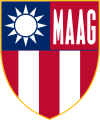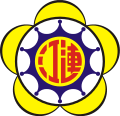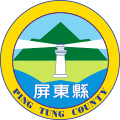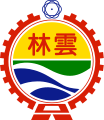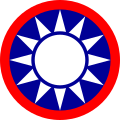Blue Sky with a White Sun
| National Emblem of the Republic of China (Taiwan) | |
|---|---|
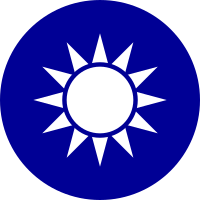 | |
| Armiger | |
| Adopted | 17 December 1928 (Nationalist government) 25 October 1945 (Taiwan) |
| Party Emblem of the Kuomintang | |
|---|---|
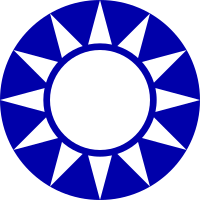 | |
| Armiger | Kuomintang |
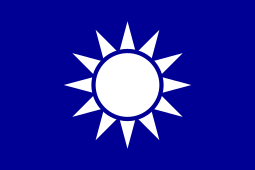 | |
| "Blue Sky with a White Sun" flag (青天白日旗) | |
| Use | Kuomintang party flag and the ROC naval jack |
|---|---|
| Proportion | 2:3 |
| Adopted | 1895 |
| Design | A white sun with twelve rays on blue background. |
| Designed by | Lu Haodong |
The Blue Sky with a White Sun (Chinese: 青天白日; pinyin: Qīngtīan Báirì) is the national emblem of the Republic of China (Taiwan).
In the "Blue Sky with a White Sun" symbol, the twelve rays of the white Sun representing the twelve months and the twelve traditional Chinese hours (時辰; shíchen), each of which corresponds to two modern hours and symbolizes the spirit of progress.[citation needed]
Official description
The national emblem of the Republic of China is officially described in the National Emblem and National Flag of the Republic of China Act:[1]
The national emblem of the Republic of China is a blue sky with a white sun in the following form:
- A blue circle.
- A white sun in the middle, with 12 white rays with pointed angles.
- There is a blue ring between the white sun and the white rays with pointed angles.
The position, angle and ratio of each subparagraph of the previous article are as follows:
- The center of the blue background circle is the center of the white sun.
- The ratio of the radius of the white sun to the radius of the surrounding blue circle is 1:3.
- The length from the center of the white sun to the top of a white ray with a pointed angle is twice the length of the radius of the white sun.
- The width of the blue ring between the white sun and the 12 white rays with pointed angles is equivalent to 1/15 of the diameter of the white sun.
- The top angle of each white ray with a pointed angle is 30 degrees, with the 12 rays totaling 360 degrees.
- The upper, lower, left and right sides of the white rays with pointed angles shall be facing north, south, east and west. The rest shall be evenly spread out.
History of the Blue Sky White Sun design
The "Blue Sky with a White Sun" flag was originally designed by
During the
When the government of the Republic of China was established on January 1, 1912, the "Five-Colored" flag was adopted as the national flag, but Sun Yat-sen did not consider its design appropriate, reasoning that horizontal order implied a hierarchy or class like that which existed during dynastic times. Thus, when he established a rival government in Guangzhou in 1917, he brought over the "Blue Sky with a White Sun" flag for the party and the "Blue Sky, White Sun, and a Wholly Red Earth" (青天白日滿地紅) flag, which was then the naval ensign, for the nation. This officially became the national flag in 1928 while the "Blue Sky with a White Sun" flag was adopted as the naval jack.
The "Blue Sky, White Sun, and a Wholly Red Earth" flag has remained the flag of the Republic of China to this day.
National emblem and history
Beiyang period
The national emblem of the Republic of China was derived from the Blue Sky with a White Sun flag. The emblem was designed by
On the national emblem rays of sun have some distance to the edge, symbolizing the broadness of the sky, while on Kuomintang emblem the rays reach the edge, symbolizing the spirit of revolution is as powerful as the sun.
The national emblem of the Republic of China from 1913 to 1928 is called Twelve Symbols national emblem, based on the traditional symbols on clothes of ancient Chinese emperors. It was designed by Lu Xun, Qian Daosun and Xu Shoushang on August 28, 1912, and was set as national emblem in February 1913. It remained as the national emblem during the Empire of China from 1915 to 1916. After the Northern Expedition it was replaced by the Blue Sky with a White Sun national emblem in 1928.
Nationalist period
Since 1928, under the KMT's political tutelage, the Blue Sky with a White Sun Flag shared the same prominence as the ROC flag. A common wall display consisted of the KMT flag perched on the left and the ROC flag perched on the right, each tilted at an angle with a portrait of National Father Sun Yat-sen displayed in the center. After the promulgation of the Constitution of the Republic of China, the party flag was removed from such a display and the national flag was moved to the center. To promote a sense of national identity, the design of the national emblem was freely available to use and was featured prominently in corporate logos, art during the era.
-
Emblem of the City of Canton (1926–1949)
-
Coat of arms of CardinalPaul Yü Pin, Archbishop of Nanking
Taiwanese period
Since the ROC government moved to Taiwan and especially in the years since the end of
The flag and the symbol made news during the
On 29 January 2021, the Legislative Yuan passed a resolution proposed by the New Power Party on 29 January instructing the Ministry of the Interior (MOI) to look into ways of addressing the issue of the similarity between the national emblem, in use since 1928 for all of China, and the KMT party flag.[7] The MOI responded that through their analysis of the current situation, the change "should not be taken lightly," though suggesting that symbols of political parties could be changed.[8]
-
The KMT (sides) and ROC (center) flags displayed at a party building in Kaohsiung.
-
TheTaiwan Railway Administrationalso used KMT emblem as their logo from 1945 to 1950.
Use in other countries
The design of "Blue Sky with a White Sun" was used in the unit insignia or coats of arms of some units of the
Up to now, the "Blue Sky with a White Sun" can still be seen in the emblem of the
-
China Burma India Theater
-
Merrill's Marauders
-
75th Ranger Regiment
-
Military Assistance Advisory Group in Taiwan
-
Flag of the People's action Party of Vietnam
Other emblems
Historical Taiwanese emblems
Taiwan's earliest emblems were used during the European periods.
In 1895, Taiwan was annexed by Japan.[9] The emblem was worn as an official clothing of the Governor's Office in Taiwan which featured a Daijishō with a Sycamore leaf and chrysanthemum branch in a brown circle.[10]
After the
Chinese Taipei
After the
Subdivisions
Provinces (streamlined)
-
Fujian(1945–2019)
-
Taiwan (1945–2018)
Counties
-
Hsinchu County (2016-2019)
-
Hualien County (before 2010)
-
Kinmen County
-
Lienchiang County
-
Penghu County
Gallery
-
Spanish Formosa (1624–1642)
-
Dutch Formosa (1624–1668)
-
Emblem on the flag of Kingdom of Tungning (1661–1683)
-
Seal of Taiwan under Qing rule (1683–1895)
-
Republic of Formosa (1895)
-
Emblem used during Japanese rule (1895–1945)
-
Standard of the President of the Republic of China (1928–present, amended in 1988)
-
Emblem of the Republic of China (1928–present) and Roundel of the Republic of China Air Force (1991–present)
-
Roundel of the Republic of China Air Force (1928–1991)
-
Roundel of the Republic of China Air Force (1928–1991), light version
-
Roundel of the Republic of China Air Force (1991–present), light version
-
Emblem of the National Reorganized Government of the Republic of China (1940–1945)
-
Emblem of Chinese Taipei (1981–present)
-
Emblem of the Republic of China with encircling text as depicted on Taiwan passports (2021–present)
See also
- History of the Republic of China
- Politics of the Republic of China
- Chinese Taipei
- Flag of the Republic of China
- Proposed flags of Taiwan
References
Citations
- ^ National Emblem and National Flag of the Republic of China Act, English
- ^ "National flag". english.president.gov.tw. Retrieved 2020-11-17.
- ^ Flight International. April 28, 1938. p. 416 Archived 2014-10-06 at the Wayback Machine (Archive). " EURASIA AVIATION CORP., 97, Jinkee Road, Shanghai."
- ^ "Eurasia Aviation Corporation - A German-Chinese Airline in China and its Airmail 1931-1943 by Peter Moeller and Larry D. Sall, paperback in color, 2007, 153 pages, great book on the history of this airline, includes a listing of First Flight covers and catalog values Archived 2014-10-06 at the Wayback Machine." China Stamp Society. Retrieved on October 4, 2014.
- Airlife, 1995. p. 6. "Chinese Ministry of Communications which declared Eurasia to be a Chinese State-owned airline. The airline then fell into more trouble as a direct result of the continuing Japanese occupation. The fleet of airliners was based in Hong Kong[...]"
- Airlife, 1995. p. 5. "The outcome of this venture was Eurasia Airlines, operating six- seater Junkers W33 airliners across Asia into China."
- ^ "Taiwan weighing necessity of changing national emblem". Taiwan News. 30 March 2021.
- ^ Wu, Su-wei (10 April 2021). "Report suggests changing KMT emblem". Taipei Times.
- ^ "アルテモンド 豆知識 / ななこ織". www.artemondo.co.jp.
- ^ "始政四十周年記念台湾博覧会写真帖 - 国立国会図書館デジタルコレクション". dl.ndl.go.jp.
- ^ "謎底揭開:原來中華奧會一直用黨徽出賽". 20 September 2016. Archived from the original on 2016-12-20. Retrieved 2016-12-18.
Sources
- Hong, Caroline (2004-11-23). "Debate heats up over claims to the sun". Taipei Times. p. 3.
External links
- Kuomintang – official website
- sac.gov.tw:本期專題:奧會模式 (in Chinese)



![Roundel of Eurasia Aviation Corporation, a defunct Chinese airline headquartered in Shanghai. [3][4][5] [6]](http://upload.wikimedia.org/wikipedia/commons/thumb/7/76/Roundel_of_the_Republic_of_China_%281930%E2%80%931943%29_%E2%80%93_Eurasia_Aviation_Corporation.svg/120px-Roundel_of_the_Republic_of_China_%281930%E2%80%931943%29_%E2%80%93_Eurasia_Aviation_Corporation.svg.png)





